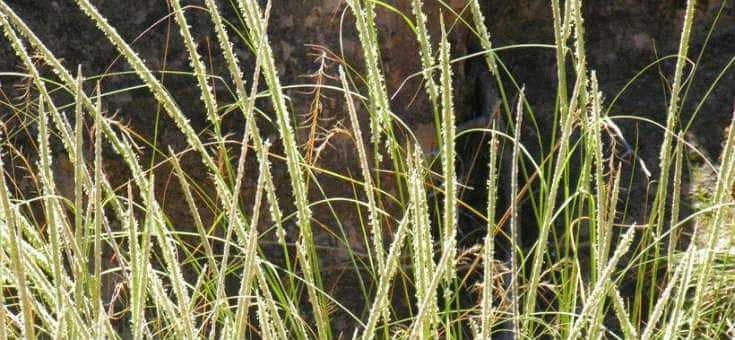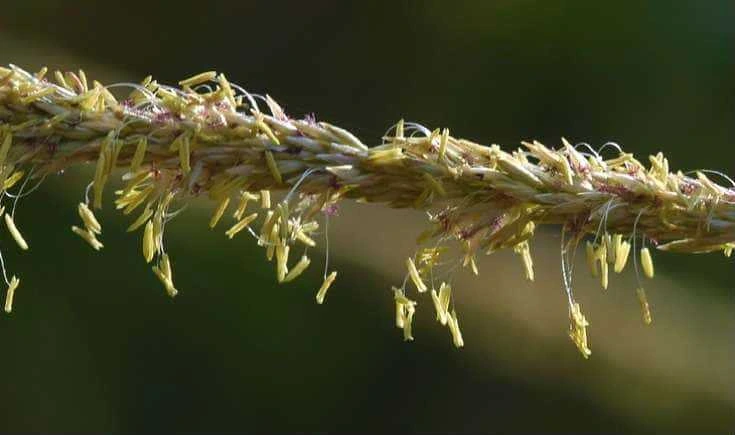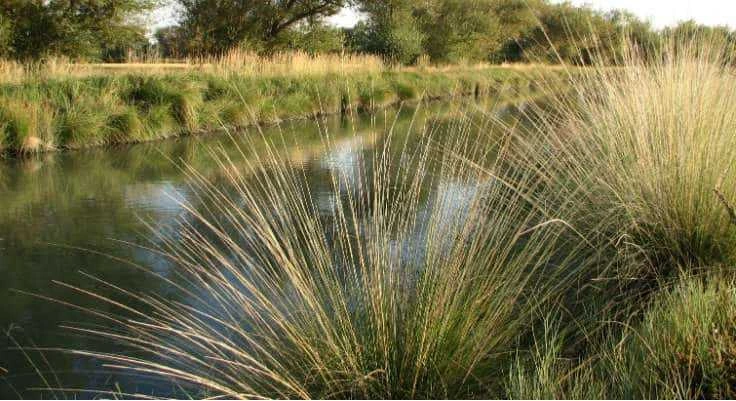Muhlenbergia rigens, commonly called deer grass, is a warm season perennial native to the dry, sandy soil of southwestern North America. Known for being low-maintenance, drought tolerant, and deer resistant, it is a popular garden and landscape staple for many homeowners throughout the country. Let’s take a look at deergrass and some of the ways it can be incorporated into personal or commercial landscaping.
Muhlenbergia Rigens Key Facts
| Fact Sheet | |||
|---|---|---|---|
| Plant Type | Grasses | Flower Color | Yellow |
| Plant Height | 4 – 5 ft | Flowering Season | Spring |
| Plant Width | 4 – 5 ft | Dormancy | Evergreen |
| Growth Rate | Fast | Water Requirement | Low |
Deer grass is a plant consisting of dense, tufted basal foliage consisting growing in clusters of narrow pointed leaves that can reach up to three feet in length. When in bloom, its flowers cream-colored flowers can increase their length up to five feet.
Young deergrass plants can act as a food source for many different types of animals, including deer. But once mature, the plants’ stalks harden and become inedible. Deergrass is so sturdy, many Native American tribes in the southwest regions used to use its mature stalks to weave baskets!
Since deer like prancing about lawns and gardens, grazing on the plants they find along the way. For this reason a plant that is deer resistant is a welcome addition for many gardens. It is the deer’s aversion to Muhlenbergia rigens that earned its name.
Further information can be found in the USDA Plant Fact Sheet for Muhlenbergia Rigens
Natural Setting
Muhlenbergia rigens is indigenous to the southwestern soil of North America. Deer grass grows wild in elevations below 7,000 feet and home to the vast prairies of California, Texas, New Mexico, and Mexico.
| Natural Setting | |
|---|---|
| Locations | Southwestern United States and Mexico |
| Soil | Sandy or gravely well-drained |
| Max. Elevation | 7000 ft |
Deergrass is not a picky grower, though. It is drought resistant, yet can tolerate heavy rains and some flooding; it prefers full sun, yet can also tolerate shade.
How to Cultivate Deergrass
Because Muhlenbergia rigens is such a hardy variety – and deer resistant! – it is a popular garden and landscape option for many homeowners. Deergrass can adapt to almost any climate in the U.S. and reaches maturity in just two growing seasons. With its tall stalks reaching out in a striking array, it is an attractive staple piece to anchor other smaller plants in a landscaped bed. Its sprawling width covers large areas of ground, cutting back on weed growth, as well.
To incorporate deergrass into the garden, consider purchasing it as a young, potted plant from a nursery. Planting young plants in the fall to take advantage of winter rains is a great strategy for establishing a healthy garden or landscape. This approach allows the plants to benefit from the increased moisture levels during the cooler months, which can lead to stronger root systems and better overall growth. Deergrass thrives in zones 5 to 11, showing off the full extent of its silvery tufts and blooms in the early spring.
Deergrass is easily mistaken for pampas grass. The former is a better alternative to other common southern California grasses due to its hardiness and deer resistance.

Deergrass Maintenance
A few years after planting, it may be time to bring new life into a deergrass plant with some simple maintenance. After several seasons of sun, the grass can become brown instead of its healthy silver-green hues. The time to prune is in the winter when the plant is dormant. Consider cutting the stalks down to the ground in December or January to remove old grown and make way for some new life.
Since older plants are very tough, try using lopping shears to prune the plant down. Since the plant’s base consists of several feet of very dense foliage, it is not uncommon for it to be full of natural debris, such as acorns, leaves, and small wildlife. Rake through the foliage with a garden rake in between snips to reach the bottom of the stalk. It can be pruned all the way to the ground.
Within two to four weeks of cutting down the deergrass stalks, the perennial will start producing small shoots of yellow and green blades. The deergrass will reach a healthy maturation in two years!
Unless experiencing a particularly severe and lengthy drought, deergrass doesn’t need extra watering. It can tolerate a wide range of annual precipitation amounts, from as little as four inches a year and up to 61 inches of rainfall. This remarkable ability to acclimate among diverse climates is part of what makes the Muhlenbergia rigens so appealing for many homeowners.
Where to Buy Deergrass
As we mentioned before, it is usually best to purchase young potted plants from a nursery and then transplant them into the ground. Try a local nursery to see the varieties available, or check out some of these links to purchase deergrass plants ready to go in the ground:
Greener Earth Nursery – deergrass is available for purchase online starting at just $19.99 for a one-gallon container. This company has high ratings and a 100% money-back guarantee. Since the plants are established in potted soil, they can ship any time of the year. Free shipping may be available for purchases over $70.
Monrovia.com also sells deergrass plants online. If the particular variety is out of stock, they offer the option of pre-ordering. Some of Monrovia’s prices may be higher than other online garden retailers, but they do offer free shipping and a satisfaction guarantee.
Deergrass Seeds

Deergrass seed is also available online. If planting deergrass from seed, do not attempt to just scatter the seed by hand. Sow the seed in pods or flats and then transfer them into the ground at least two to three feet apart. The seeds will require exceptional heat to germinate.
Larner Seeds is a California company specializing in seeds well suited for arid California climates. They offer packets of deer seeds for just $6.50, and quantities up to one pound of seed for $195.00.
Rare Exotic Seeds offers free shipping on all orders over $50 and has a wide range of seed quantities available for online purchase.
Other California Native Grasses
The California Native Plant Society (CNPS) boasts of the many benefits native California grasses have to offer. They focus on landscapers and homeowners alike.
California grasses have low water requirements and do not need frequent maintenance. They are not typically a food source for insects, and therefore do not require pesticides. These grasses are also a striking addition to any landscape.
There are over 300 species of grasses native to California. Here are 5 of the most common:
- Bouteloua gracilis is a low-growing variety that thrives in dry, arid climates.
- Festuca California is a lush, medium-sized bunch of grass with vibrant green foliage and stiff stalks. It does well in shaded areas.
- Leymus condensatus, or “Canyon Prince” is characterized by blue-green blades that can tolerate both sun and shade.
- Calamagrostis foliosa is a full bunch grass that can grow up to two feet tall.
- Carex tumulicola is a wispy grass that does not grow in bunches. It grows in Northwestern North America, all the way up to British
- Columbia in meadows and open plains.
Some may also be great as a dog friendly grass in the garden.
Arizona Native Grasses
In addition to Muhlenbergia rigens, Arizona landscapes can be accentuated with several attractive bunched grass plants that thrive within the desert climate.
Here is a short list of Arizona native grasses:
Pink Muhly Grass
Pink Muhly Grass has a whimsical pink hue, grows up to four feet tall, and needs water once a week. Very common grass in Arizona.
Mexican Feathergrass
Mexican Feathergrass is a small, ornamental grass that grows up to 18 inches tall and needs watering 1 to 2 times a month.
Bear Grass
Bear Grass blooms white flowers late in the spring and displays unique, curly strands. It can grow up to four feet tall and needs water once or twice a week.
Conclusion
Deergrass is an excellent option for gardens and lawns. Low maintenance, low water requirements, affordability, and deer resistance will continue to guarantee its popularity among American lawns for years to come!

